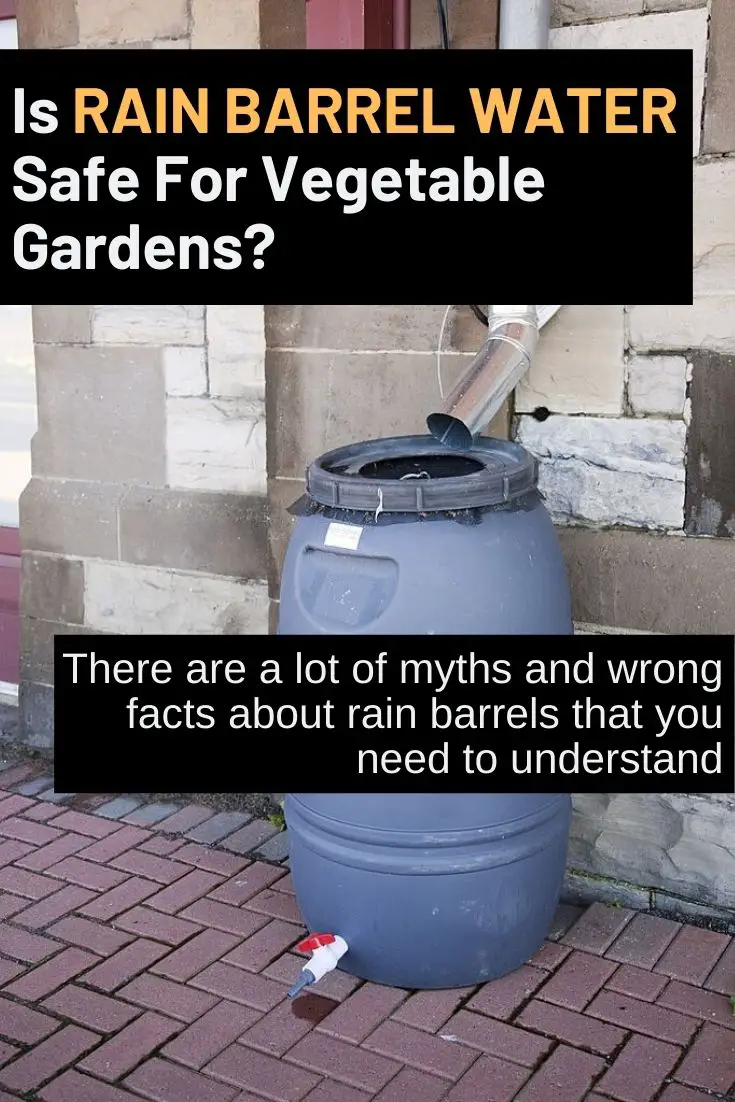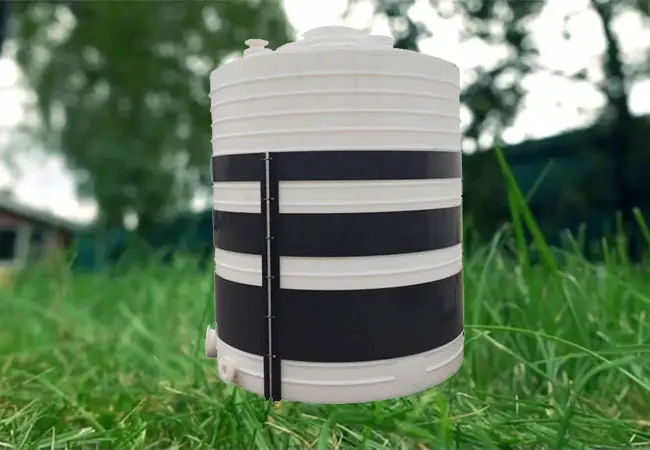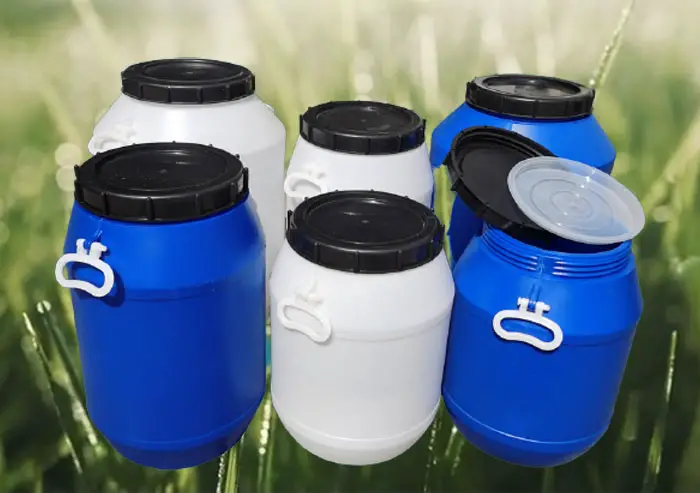In the world of keeping your vegetable garden fed with water, it can be challenging to find a source of water that does not cost an arm and a leg. Many people quickly create a rain barrel system that catches all the extra water that usually goes to waste on the ground. You may already have such a system in your house, but is it really safe to use for vegetables?
It is extremely safe to use rain barrel water for your vegetable garden. The water gathered from rain is a lot more nutrient-rich, which will promote rapid growth in your vegetable garden. Many vegetable garden owners what to go off the grid, and using rain barrel water for more than just the vegetable garden is always an option.
There are a lot of myths and wrong facts about rain barrels that you need to understand. These are made by people who have had bad experiences or want to promote their own water gathering. Water from rain barrels can be some of the most useful and versatile water sources, and many people always work towards creating complete systems that eventually replace any government supply.
These are the things you will need to know about rain barrel water and the basics of these systems!
Benefits Of Rainwater Collection
Rain barrels can be a great asset for those looking to save money, conserve water and reduce runoff in vegetable gardens. The benefits of collecting rainwater are numerous; from reducing our reliance on municipal sources to providing plants with natural nutrients, there’s no doubt why so many gardeners use this age-old practice today.
The first advantage of using rainwater is cost savings. Depending on your location, running tap water through hoses and sprinklers can become costly over time. Collecting and storing rainwater eliminates this expense completely, as well as reduces the energy needed to treat and pump water from its source. Not only will you save money in the long run but also help cut down on carbon emissions associated with traditional water treatment processes.
Additionally, rainfall contains essential plant nutrients such as calcium, magnesium, nitrogen, and phosphorus which aren’t found in treated city water supplies. These elements provide vital nourishment for vegetables growing in soil-based systems like raised beds or container gardening setups. Vegetables grown with harvested rainwater often have improved taste profiles due to the added minerals imparted by nature itself.
Potential Contaminants In Rainwater
Rainwater collected from a rain barrel can contain a variety of contaminants that may be harmful to vegetable gardens. In most cases, the water is filtered through the roof and gutters before it reaches the collection container; however, these filters are not enough to remove all potential pollutants. Common sources of contamination include bird droppings, car exhaust, bacteria and other microscopic organisms in air pollution, and pesticides used on lawns or nearby crops.
The good news is that many of these contaminants can be eliminated by treating the rainwater with filtration systems or UV light sterilization. By doing this, gardeners can ensure their vegetables are growing in safe and clean water. Additionally, regular maintenance of the rain barrels such as cleaning screens and replacing any worn-out parts will help reduce the chance of contaminated water reaching plants.
In order to assess whether your rainwater is suitable for use in your vegetable garden, it’s important to test its quality periodically throughout the season. This way you can make sure there aren’t any contaminants present that could potentially harm your plants over time.
How To Test Rainwater Quality
Testing the quality of rainwater is a key part of evaluating its safety for vegetable gardens. Fortunately, there are several reliable methods that can be used to assess water quality quickly and accurately.
The first step in testing rainwater is to determine pH levels. This indicates whether or not the water is acidic or basic; the ideal pH for garden use range from 6-7.5. Homeowners can purchase an easily portable pH kit at most hardware stores; it will provide accurate results within minutes with minimal effort required on their part.
Another important factor in assessing the quality of rainwater is determining salinity levels, as this affects how effectively plants absorb nutrients from soil and water sources. The best way to measure salinity is through electrical conductivity (EC), which measures the number of ions present in a given sample. If EC readings exceed 1 dS/m, then homeowners should consider treating their collected rainwater before using it in gardens or other outdoor areas.
To ensure safe water for gardening purposes, owners should also check for hardness, alkalinity, mineral content, nitrates, and suspended solids in addition to measuring pH and EC levels—all factors that affect overall water quality and plant health outcomes.
Treatment Options For Rainwater
Rainwater can be a great asset for vegetable gardens, but it is important to ensure that the rain barrel water is safe for use. The best way to do this is by testing the water quality beforehand. After obtaining the results from the test, there are several treatment options available depending on what was found in your sample.
Using figurative language, these treatment options essentially boil down to two main choices: fixing the problem or filtering out contaminants. Let’s take a closer look at each option and its advantages:
Fixing
This involves identifying and addressing any issues present in your rain barrel water before using it in your garden. This could involve treating bacterial contamination with chlorine bleach or adjusting pH levels with an alkaline solution like baking soda. Doing so helps reduce health risks associated with consuming contaminated produce while also helping protect beneficial insects and soil organisms in the garden ecosystem.
Filtering
If you are unable to fix any problems found in your rain barrel water, then another option would be to filter out any contaminants present. This can either involve installing a mechanical filtration system such as activated carbon filters or reverse osmosis systems or using natural methods such as sand filtration or settling tanks. While not always feasible due to cost and space constraints, this method of purifying rainwater can prove effective over time if done correctly.
Whichever approach you decide to take when treating your rainwater will depend on both budget considerations and desired outcomes regarding water quality standards needed for gardening purposes. Regardless of which route you choose, however, taking steps towards making sure that your rainwater is safe enough for use in vegetable gardens should always be part of proper garden maintenance practices.
Nutrient Content Of Rainwater
Rainwater is often thought to be an ideal source of water for vegetable gardens, but it’s important to consider its nutrient content. Rainwater collected in a rain barrel can contain various minerals and other chemicals that could potentially damage plants if the concentration levels are too high. Fortunately, there are ways to mitigate this risk.
The first step is to determine what nutrients may already exist in your rainwater before using it on your vegetables. For example, nitrogen and phosphorus from atmospheric deposition or runoff can increase concentrations of these elements within a rain barrel, which can have adverse effects on some vegetables. Testing your water prior to use is recommended so you know exactly what kind of fertilizer inputs you’ll need to maintain healthy garden growth.
Another factor worth considering when evaluating the quality of your rainwater is pH levels. Most vegetables prefer slightly acidic soil with a pH between 6-7; however, acidity levels can change depending on factors like air pollution or soil type surrounding the collection site. Checking the pH level of water before irrigating will help ensure proper nutrition for crops as well as limit any potential plant stress caused by extreme alkalinity or acidity.
Filtration Methods For Rainwater
Recent studies indicate that nearly one-third of all households around the world are using rainwater harvesting as an alternative water source. As such, it is important to understand the best methods for ensuring that rain barrel water is safe for vegetable gardens and other uses. Here are four primary filtration methods used to make rainwater more suitable for use:
- Screening – Screening can be done with a coarse mesh filter or a sieve placed over the opening of the collection tank. This will help to limit large debris from entering the tank, including animals and leaves.
- Sedimentation – Sedimentation involves allowing particles in the water to settle out before it enters the storage vessel by letting it sit undisturbed for several hours or longer if possible.
- Disinfection – Disinfection should always be used regardless of any other filtration method employed because it helps reduce levels of bacteria and viruses in stored water. Methods include chlorine, ultraviolet light, ozone gas, boiling, and solar disinfection (SODIS).
- Filtration – Filtration through fine media like charcoal can also be useful when collecting rainwater because this helps remove suspended solids which can affect taste and odor as well as potentially contain harmful contaminants such as metals or pesticides.
It is important to remember that even though these filtration methods may improve quality there still could remain some microorganisms present so additional precautionary measures should be taken prior to consuming harvested rainwater directly or using it on edible crops in vegetable gardens. For example, testing regularly either at home with kits available online or sending samples off to a lab would provide peace of mind about safety when relying on collected rainwater for irrigation purposes or drinking needs.
Best Practices For Collecting And Storing Water
Harvesting rainwater for vegetable gardens is a great way to conserve resources and save money. It’s important, however, to practice safe harvesting methods in order to make sure the water is clean and healthy for your garden. Here are some best practices for collecting and storing water from your rain barrel:
First, it’s essential that you locate your rain barrel at least five feet away from any potential sources of contaminants such as windows or air conditioners. This will help ensure that no pollutants enter the collection system. Additionally, be sure to inspect the area around the barrel regularly so debris doesn’t accumulate near it.
Next, it’s wise to install a screen filter on top of your rain barrel to prevent leaves and other large particles from entering the water supply. You should also test the pH levels of collected water before using it in your garden; acidic waters can damage plants if used too frequently. If necessary, add an alkaline buffering agent like baking soda or limestone chips to adjust the pH levels appropriately.
Finally, be sure to cover your rain barrel with a tight-fitting lid when not actively collecting water. Not only does this provide an extra layer of protection against sediment accumulation but also prevents mosquito breeding sites by blocking out light.
Maintenance Requirements For Rain Barrels
Maintaining a rain barrel is an important part of ensuring your vegetable garden has a safe and reliable water source. There are several steps you need to take in order to keep your rain barrel clean, free from debris and pests, and functioning properly.
First, regular cleaning is essential for keeping the rain barrels debris-free. Leaves, twigs, and other organic materials that fall into the barrel should be removed regularly. This can be done manually with a net or hose attachment, but it’s also possible to install filters on top of the barrel to prevent large objects from entering. Additionally, make sure to empty any standing water out of the barrels after heavy rainfall events.
Second, inspect your rain barrels frequently for signs of leaks or damage. If left unchecked, these issues could cause major problems down the line if not addressed promptly. Check around all joints and seals where the parts connect – if there’s seepage here then it’s time to get it fixed up right away.
Lastly, pest control measures should be taken as needed. Mosquitoes may lay eggs in stagnant water so routinely remove any larvae or pupae found in the bottom of your tank; use mosquito dunks or another appropriate chemical treatment when necessary. Also, watch out for rodents such as mice or rats nesting near or around your rain barrels – they can transmit diseases directly into your drinking water supply.
Advantages Of Using Rainwater In The Garden
Rainwater is an excellent resource for watering vegetable gardens. It is free, abundant, and full of nutrients that can benefit plants. Using rain barrels to collect water from your roof or gutter system helps conserve resources, reduce runoff, and save money on outdoor water bills. There are several advantages of using rainwater in the garden.
Firstly, it contains no chlorine or fluoride, meaning fewer chemicals are added to the soil. Rainwater also has a neutral pH level which makes it ideal for most types of vegetation as it does not contain any salts or minerals like tap water does. This means you don’t need to worry about over-fertilizing your veggies with too much nitrogen or other compounds found in fertilizers.
Secondly, introducing rainwater into the soil encourages beneficial microbial activity. The presence of microbes such as bacteria and fungi improves soil structure, increases nutrient availability, and promotes better root growth amongst vegetables. Therefore, regular applications of collected rainwater will help keep your garden healthy while reducing the time spent weeding and maintaining beds.
Lastly, collecting run-off from roofs helps decrease strain on local drainage systems during heavy downpours when storm drains become overwhelmed by excessive amounts of surface water. By diverting this excess away from our streets and into a barrel instead, cities can avoid costly flooding damage caused by clogged sewers and overflowing rivers. With these benefits in mind, many homeowners have started integrating large rain collection systems into their yards for maximum efficiency.
Disadvantages Of Using Rainwater In The Garden
As with any natural resource, there are certain drawbacks to using rainwater in a garden. While it can be an effective tool for irrigation and conserving precious drinking water, it is important to understand the potential dangers associated with harvesting rainfall. Like a double-edged sword, rain barrels provide benefits while also bringing risks that must not be overlooked.
The first disadvantage of collecting rainwater lies in its lack of nutrient content. Rainwater does not contain plant food or other nutrients needed by plants to thrive; therefore, supplemental fertilizer must be added regularly if vegetables are being grown with harvested rainwater. Without adequate nutrition, gardens may suffer from stunted growth and yellowed leaves.
Another risk arises when chemicals used on nearby surfaces wash into collected rainwater. If homeowners apply herbicides or insecticides to their lawns or use treated wood near their rain barrel setup, these contaminants could end up in stored water and later be absorbed by plants growing in the garden soil. It is best practice to keep any chemical applications far away from collection areas to reduce this threat as much as possible.
Because of these disadvantages, many gardeners opt for a combination approach where they mix some store-bought tap water with their collected supply each time they irrigate their vegetable beds. This way they get the benefit of conservation without sacrificing too much quality control over what ends up in their crops’ root systems.
How Long Does It Take To Fill A Rain Barrel?
There are many ways to fill the rain barrel, the chief of which should always be using the rain that falls on your roof to fill it. Many systems have been built to fill rain barrels with the water needed to keep them full, with some systems connected to underground water sources and the roof.
The speed at which the barrel will fill depends on the size of the barrel and the total area that will be gathering up water. Larger barrels can take a lot longer to get filled, even with help from a borehole, but will be able to last a lot longer and be used for household chores as well.
Many people create water collection systems that do not have enough area to collect rainwater actively. However, if the area is large enough and the rain barrel has been connected properly, it should only take one mildly large storm for the rain barrel to be filled with water.
What Is The Longest You Can Water Your Garden With A Rain Barrel?
Many people will question whether a rain barrel is not worth getting because they have seen systems that could not water a garden for more than a day. Other people will tell stories of their rainwater systems, easily collecting water for only a few hours and providing more water than they know what to do with.
Your rain barrel needs to be scaled to the garden you will be using, with a smaller garden a 55-gallon tank easily lasts for most of the year, while larger gardens require much more complex systems. Some of the best stories of rain barrels working are when the owners know how much water they use regularly.
The best rain barrel systems will never run out of water, fill during the rainy season, and only get close to empty near the end of the dry season. After all, if a system has been built properly, even a small rain that only lasts for an hour should be enough to refill it easily.
Why Do People Prefer To Use Rainwater?
Many vegetable garden owners will up and down the street that there is no better water source than rain barrel water. These people have usually seen rapid growth in their gardens after switching to this natural source of water. It can be confusing knowing why they would prefer this water if so many people actively spread fear about acid rain.
Rain barrels have the best parts of rain all in one. As the water sits in the barrel, most impurities can cause acid rain to settle to the bottom. When you use the water in your garden, you use clean, fresh water with only the nutrients needed to grow properly.
For this reason, even if the roof you are collecting the water from is a bit dusty, you can still drink the water if it is absolutely needed. This water is nutrient-rich and can seldom be replaced by simple water from the tap.
What Are The Things Needed To Ensure The Water Does Not Turn Bad?
You will need to have three things in place to ensure the water never turns bad or into a mold and algae-infested problem. These are the things you should consider while building the initial framework of the system, and you should never ignore them in favor of building with more ease.
- Sealed System: The system needs to be entirely sealed when you are not working on it, ensuring that the only things that can enter the tanks are water and air to relieve pressure. Many people forget that you need to keep it entirely sealed and that even a slow leak can cause unwanted contamination. Once mold and algae start growing inside the tank, they can be challenging to remove.
- No Sunlight: It might not always be possible, but the barrel you are using should receive as little as possible sunlight each day. This keeps the water inside from heating up and stops any unwanted bacteria from easily and comfortably growing inside the barrel. Many times, people are unaware that just the presence of the sun can cause much unwanted bacterial growth in water systems.
- Filtered Intake: It is a more controversial addition to the world of rain barrels but adding in small filters before the initial intakes can help stop a lot of unwanted large debris from entering your system. Some of the best systems will have weir systems that capture any unwanted leaves or seeds before they get the chance of getting lodged inside your water barrel system.
Where Else Can You Use Rainwater?
You might be wondering what the full use case is for having larger-than-life rain barrels on your property, usually taking up so much space you are considering buying a few more acres to live comfortably. The uses for rainwater are almost endless, and with the proper care can eventually start replacing the municipal water you get entirely.
Cleaned, and you can use filtered rainwater for normal tap water, pool water, cleaning water, and any water that you may be using in your home. There is no end to the use of this water, and once you start using rain barrel water, you will find yourself not needing much water from other sources unless it has been a terrible weather day.
For this reason, many vegetable garden owners eventually stop using water from the municipality, as the water they collect from rain has become the only source of water they will ever need.
Which Rooves Are Best To Collect Water From?
The world is filled with every type of roof you can imagine, with many rooves not always the best to handle a rainwater collection system. A thatched roof will never work as well as other rooves, while smaller ones can never collect as much as larger ones.
It is always best to use tiled or corrugated rooves to collect rainwater. These rooves have no extra contamination and already have full systems that collect the water to specific points on the roof. This allows you to connect your new rainwater collection system to them, diverting the water away from the ground and into your rain barrel.
If you ever wonder why most vegetable garden owners are building smaller houses to have their rain barrels in them, this is why. If you have a large house, it can be easier and more cost-effective to build a small house used to collect the water than anything else.
Conclusion
Rain barrels are some of the most effective ways of collecting water and reusing it to keep your garden looking good and continually growing. If you are ever wondering how to make your monthly spending a lot less, this would be the way to go, knowing that the water is completely safe to use for most household activities.
Just be that you aren’t drinking water from the bottom of the tank. There might be a few things floating there you won’t want.
Read also:
Did you find this post useful? Would you like to get back to it later? Save THIS PIN below to your garden and vegetable boards on Pinterest! Thanks 🙂




